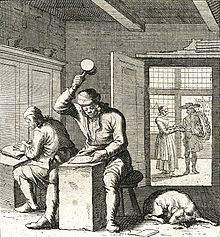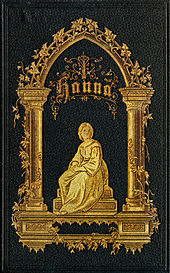Gold leaf
This article needs additional citations for verification. (December 2009) |

Gold leaf is
.Gold leaf is a type of
Traditional water gilding is the most difficult and highly regarded form of gold leafing. It has remained virtually unchanged for hundreds of years and is still done by hand.
History
5,000 years ago,
Gold-leaf forging is a traditional handicraft in
Production


The process of hammering gold into leaf is known as goldbeating.
The
After rolling, the ribbon of gold is cut into one-inch squares. The first step in the beating process is called the cutch.
The gold is beaten on a large, heavy block of marble or granite. These stone blocks were sometimes placed on top of a tree trunk set deep into the ground. This created greater resiliency for the hammer. Beating of the cutch by hand takes about one hour using a fifteen-pound hammer. The goldbeater follows a pattern and sets up a rhythm, striking the packet with up to seventy strokes a minute[citation needed] . The packet is rotated and turned over to ensure that the gold inside expands evenly in all directions. The original small squares of gold are beaten until they have expanded to the outer edges of the four inch square cutch. The gold is taken out of the cutch and each piece is cut into four pieces with a knife. Using the pincers, these squares of gold are put into a second packet called the shoder, which has approximately 1,500 skins. The shoder is beaten for about three hours until the gold has expanded to a five-inch square.
The gold is taken out of the shoder and placed on a leather-covered surface. The gold is thin enough now that the cutter can simply blow on it to flatten it out.[clarification needed] Using a wooden implement called a wagon, the gold is quickly cut into four pieces and immediately placed in a packet called a mold for the final beating.[3] The wagon has sharp cutting blades, traditionally made from malacca cane (rattan). The mold contains 1,500 pieces of gold. Before the mold is filled with gold, the skins are coated with a gypsum powder. This process prevents the delicate gold leaf from sticking to the skins.[17] The mold is beaten with an 8-pound (3.6 kg) hammer for three to four hours until it has been beaten into a circle about six inches (15 cm) in diameter. The finished leaf forms an unbroken sheet of gold with a thickness of approximately 100 nanometres (1⁄250000 in). After the leaves are taken out of the mold, they are conventionally cut into a three-and-three-eighths-inch (8.6 cm) square and packaged in tissue-paper books containing twenty-five leaves.
Uses

Art
Gold leaf is sometimes used in art in a "raw" state, without a gilding process. In cultures including the
The
In Western
"Gold" frames made without leafing are also available for a considerably lower price, but traditionally some form of gold or metal leaf was preferred when possible and gold leafed (or silver leafed) moulding is still commonly available from many of the companies that produce commercially available moulding for use as picture frames.
Architecture
Gold leaf has long been an integral component of architecture to designate important structures, both for aesthetics and because gold's non-reactive nature provides a protective finish.
Gold in architecture became an integral component of Byzantine and Roman churches and basilicas in 400 AD, most notably

In
In
Gold leaf adorns the wrought iron gates surrounding the Palace of Versailles in France, when refinishing the gates nearly 200 years after they were torn down during the French Revolution, it required hundreds of kilograms of gold leaf to complete the process.[21]
Cuisine

Gold leaf (as well as other
In
, which is perhaps the best known in both Canada and the United States.See also
References
- ^ Vilfranc, Jenifer M. (1999). Elert, Glenn (ed.). "Thickness of gold leaf". The Physics Factbook. Retrieved 2022-03-05.
- ^ "gold leaf | art". Encyclopædia Britannica. Retrieved 2017-06-20.
- ^ .
- ^ 叶聪 (2014-07-15). ""南京非遗"文化视域下的家具产品创新设计研究". (金陵科技学院,南京 211169).
- ^ "第一批國家非物質文化遺產-南京金箔锻制技艺". 愛學術. Retrieved 2021-07-30.
- ^ "南京金箔鍛製技藝". 龍媒網. Retrieved 2021-08-02.
- ^ "【國家級非物質文化遺產系列玖】南京金箔鍛製技藝". 蓮花時報. Retrieved 2021-08-11.
- ^ 管秋惠. "南京金箔鍛製技藝". 參考網. Retrieved 2021-08-11.
- ^ "古老技藝"點亮"現代生活 金箔文創亮相南京". 中國新聞網. 2019-05-20.
- ^ 丁婷 (2019-05-20). "南京金箔传统锻制技艺的保护与传承研究". 博碩論文_南京師範大學. Archived from the original on 2021-11-14. Retrieved 2023-05-03.
- ^ "萬錘鍛製箔金來". 澳門日報. 2020-08-16. Archived from the original on 2021-11-14. Retrieved 2023-05-03.
- ^ "南京金箔锻制技艺". 学科分类—综合性图书 五洲传播出版社《中国辞典》第327页. 2021-11-14.
- ^ "南京金箔——萬錘鍛制箔金來". 新華網. 2020-07-26.
- ^ "南京金箔博物馆免费开放". 揚子晚報. 2017-03-07.
- ^ "当春联遇上非遗!金陵金箔"闹新春"". 我苏网. 2021-02-17.
- ISBN 9780195313918. Retrieved June 30, 2017 – via Google Books.
- ^ Chambers; Patrick, David; Geddie, William (1901). Chambers's encyclopaedia: A dictionary of universal knowledge. p. 283.
- ISBN 9780297779032.
- ^ Charles A. Coulombe, Vicars of Christ, p. 330.
- ^ "Survey of London: Volumes 29 and 30, St James Westminster, Part 1", British History Online, 1960, retrieved 9 April 2015
- ^ ""L'ameublement de la chambre de Louis XIV à Versailles de 1701 à nos jours"". Gazette des Beaux-Arts (6th Ed.): 79–104. February 1989.
- ISBN 978-0794602550. Retrieved 2013-08-15.
- ^ "Japanese Culture/The Way/Tea ceremony/Let's Try". www.city.kanazawa.ishikawa.jp.
External links
- Gold Beating sections from 1903 American Library Edition Of Workshop Receipts Vol5 by Ernest Spon
- Goldschlägerstadt Schwabach Archived 2009-02-26 at the Wayback Machine (in German) partly illustrated history of goldbeating
- Gold Beating 1959 and Gold Beating Out Takes 1950-1959, two British Pathénewsreel clips depicting the goldbeating process
- . Encyclopædia Britannica (11th ed.). 1911.






